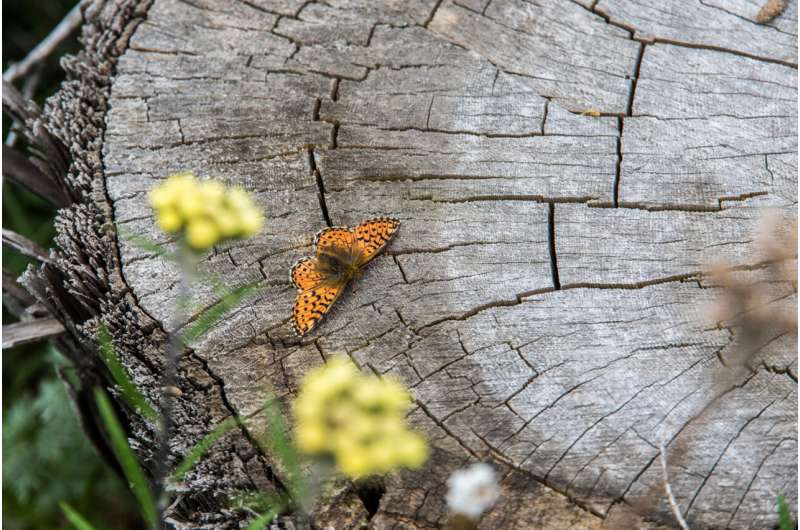Old-growth trees more drought tolerant than younger ones, providing a buffer against climate change

A new analysis of more than 20,000 trees on five continents shows that old-growth trees are more drought tolerant than younger trees in the forest canopy and may be better able to withstand future climate extremes.
The findings highlight the importance of preserving the world's remaining old-growth forests, which are biodiversity strongholds that store vast amounts of planet-warming carbon, according to University of Michigan forest ecologist Tsun Fung (Tom) Au, a postdoctoral fellow at the Institute for Global Change Biology.
"The number of old-growth forests on the planet is declining, while drought is predicted to be more frequent and more intense in the future," said Au, lead author of the study published online Dec. 1 in the journal Nature Climate Change.
"Given their high resistance to drought and their exceptional carbon storage capacity, conservation of older trees in the upper canopy should be the top priority from a climate mitigation perspective."
The researchers also found that younger trees in the upper canopy—if they manage to survive drought—showed greater resilience, defined as the ability to return to pre-drought growth rates.
While deforestation, selective logging and other threats have led to the global decline of old-growth forests, subsequent reforestation—either through natural succession or through tree planting—has led to forests dominated by increasingly younger trees.
For example, the area covered by younger trees (<140 years old) in the upper canopy layer of temperate forests worldwide already far exceeds the area covered by older trees. As forest demographics continue to shift, younger trees are expected to play an increasingly important role in carbon sequestration and ecosystem functioning.
"Our findings—that older trees in the upper canopy are more drought tolerant, while younger trees in the upper canopy are more drought resilient—have important implications for future carbon storage in forests," Au said.
"These results imply that in the short term, drought's impact on forests may be severe due to the prevalence of younger trees and their greater sensitivity to drought. But in the long run, those younger trees have a greater ability to recover from drought, which could be beneficial to the carbon stock."
Those implications will require further study, according to Au and colleagues, given that reforestation has been identified by the Intergovernmental Panel on Climate Change as a potential nature-based solution to help mitigate climate change.
The Sharm el-Sheikh Implementation Plan published during the 2022 United Nations Climate Change Conference in Egypt (COP27) also reaffirmed the importance of maintaining intact forest cover and associated carbon storage as a social and environmental safeguard.
"These findings have implications for how we manage our forests. Historically, we have managed forests to promote tree species that have the best wood quality," said Indiana University's Justin Maxwell, a senior author of the study.
"Our findings suggest that managing forests for their ability to store carbon and to be resilient to drought could be an important tool in responding to climate change, and thinking about the age of the forest is an important aspect of how the forest will respond to drought."
The researchers used long-term tree-ring data from the International Tree-Ring Data Bank to analyze the growth response of 21,964 trees from 119 drought-sensitive species, during and after droughts of the past century.
They focused on trees in the uppermost canopy. The forest canopy is a multilayered, structurally complex and ecologically important zone formed by mature, overlapping tree crowns.
The upper canopy trees were separated into three age groups—young, intermediate and old—and the researchers examined how age influenced drought response for different species of hardwoods and conifers.
They found that young hardwoods in the upper canopy experienced a 28% growth reduction during drought, compared to a 21% growth reduction for old hardwoods. The 7% difference between young and old hardwoods grew to 17% during extreme drought.
While those age-related differences may appear fairly minor, when applied at the global scale they could have "huge impacts" on regional carbon storage and the global carbon budget, according to the study authors. That's especially true in temperate forests that are among the largest carbon sinks worldwide.
In the study, age-related drought-response differences in conifers were smaller than in hardwoods, likely because needle-bearing trees tend to inhabit more arid environments, the researchers say.
The current study was part of Au's doctoral dissertation at Indiana University, and he continued the work after joining U-M's Institute for Global Change Biology, which is based at the School for Environment and Sustainability.
The new study is a synthesis that represents the net effects of thousands of trees in diverse forests across five continents, rather than focusing on single forest types. In addition, the new study is unique in its focus on trees in the upper forest canopy, which reduces the confounding effects of tree height and size, according to the authors.
In addition to Au and Maxwell, the study's authors include Scott Robeson, Sacha Siani, Kimberly Novick and Richard Phillips of Indiana University; Jinbao Li of the University of Hong Kong; Matthew Dannenberg of the University of Iowa; Teng Li of Guangzhou University; Zhenju Chen of Shenyang Agricultural University; and Jonathan Lenoir of the UMR CNRS 7058 at Université de Picardie Jules Verne in Amiens, France.
More information: Younger trees in the upper canopy are more sensitive but also more resilient to drought, Nature Climate Change (2022). dx.doi.org/10.1038/s41558-022-01528-w
Journal information: Nature Climate Change
Provided by University of Michigan





















